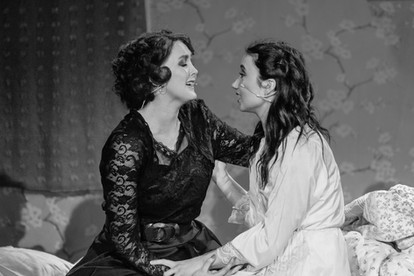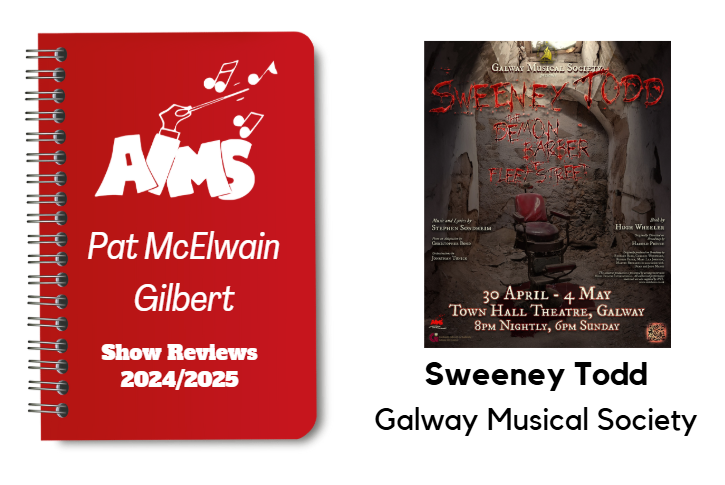West Side Story as presented by Bellvue Academy of Performing Arts
- Darragh Carroll

- May 7
- 7 min read

Society name: Bellvue Academy of Performing Arts
Show name: West Side Story
Adjudicator date of attendance: 02/03/2025
Brief Overview of Show and Evaluation of Front of House
Bellvue Academy of Performing Arts tackled the emotionally rich West Side Story with remarkable ambition and care. Taking on such a demanding piece—with its challenging vocals, complex choreography, and mature themes—is a bold choice for a youth company, and Bellvue rose to the challenge with thoughtfulness and sincerity.
The production was polished, well-rehearsed, and emotionally resonant, with strong performances across the board. From street battles to tender ballads, the show maintained a strong pace and clear sense of narrative tension.
Front of House was welcoming and professional. Staff were well organised and the atmosphere in the venue was supportive and excited. It’s clear the community takes pride in the academy’s work, which created a lovely sense of occasion.
Director – Direction and Production
Lisa Kelly’s direction balanced emotional depth with clear storytelling. She brought out mature, committed performances from a young cast, and the narrative was handled with clarity and sensitivity. Relationships between characters were well-developed, with emotional beats landing effectively.
Accent work was generally strong, with only a few slips during heightened scenes. Given the age of the cast, the consistency achieved is to be commended. A suggestion for future productions would be to make fuller use of the platforms and vertical space—greater variation in staging levels could help elevate key dramatic moments.
Lisa’s ability to guide her cast through such emotionally weighty material with confidence and clarity was truly impressive. The result was a production that respected the original while making space for youthful authenticity.
Musical Director – Direction and Orchestra
Niall Kelly’s musical direction was outstanding. The orchestral sound was lush and well balanced, providing dynamic support without overwhelming the singers. The harmonies were tight, and vocal phrasing was thoughtful, especially in complex group numbers.
His control of dynamics ensured that even underscored dialogue felt natural and allowed the emotion of the scenes to breathe. Soloists were supported with care, and ensemble numbers had drive and texture.
The musical foundation Niall built allowed the performers to explore character and emotion with confidence, and the result was a musically rich and emotionally powerful production.
Choreographer – Choreography
Keith Green’s choreography paid homage to Robbins’ original work while remaining accessible and achievable for a youth cast. The Prologue and Dance at the Gym had recognisable elements from the classic choreography but were performed with energy and commitment. “America” stood out for its verve, although slightly repetitive movement patterns might be diversified in future to maintain variation. There’s also scope to further involve the wider ensemble, as some chorus members were left on the edges rather than actively engaged in the action. Nevertheless, Keith's choreography was age-appropriate, well-executed, and stylistically coherent, showcasing the cast’s talents effectively.
Leading Principals – Singing and Acting
Tony – Ciaran Cotter. Ciaran delivered a compelling performance as Tony, with a clear and expressive tenor voice. His portrayal had charm and sincerity, with strong emotional transitions throughout. Greater awareness of physical space—particularly in close, intimate moments—would enhance future performances, but this was a standout portrayal filled with potential.
Maria – Aoibhe Condon. Aoibhe captured Maria’s sweetness and emotional growth beautifully. Her soprano voice was bright, controlled, and expressive. The chemistry between Maria and Tony felt authentic, and her journey through innocence to heartbreak was genuinely moving.
Riff – Nathan Dalton. Nathan was magnetic as Riff. He brought controlled aggression, leadership, and energy to the role. Occasionally, directing energy too far downward softened his impact—maintaining a lifted focus would further his connection to both scene partners and audience. Still, a highly impressive performance.
Bernardo – Conor O’Donoghue. Conor’s Bernardo had authority and sensitivity. His accent work was strong, and his presence was both imposing and nuanced. The balance between caring brother and hot-headed rival was well judged.
Anita – Saoirse Scully. Saoirse gave a solid performance as Anita, with good physicality and clear vocals. While she played the role with assurance, a touch more range in emotional expression could elevate her portrayal to match the dynamic shifts Anita experiences throughout the show.
Supporting Roles – Singing and Acting
Rosalia – Faye Flavin. Faye was a bright and had an engaging presence. She provided strong vocal support in “America” and interacted well with the other Shark girls. Her dance ability was strong, and she held her own alongside more dominant characters, adding depth to the female ensemble.
Doc – Zara O’Mahony. Zara gave a thoughtful and grounded performance. She brought authenticity and maturity to the role, managing to portray an older character with subtle physical and vocal adjustments. Her concern for the boys felt heartfelt, and her scenes provided important emotional ballast.
Lt. Shrank – John Bradbury. John’s take on Shrank was intense and unsettling—exactly as it should be. His choices were bold and effective, and he maintained a consistent accent and energy throughout. He held the stage well and played the authority figure with confidence.
Officer Krupke – Peter Kennedy. Peter brought a light-hearted touch to his role. Just a touch more clarity in dialogue delivery would help the humour land even better, as some lines were lost. Embracing a larger physical presence would also help define the character more fully.
Action – Keenan Scully. Keenan gave a fiery, compelling performance. He managed to portray Action’s volatility with great control, never tipping into overacting. His physicality was striking, and he brought real tension to his scenes. A standout supporting performance that captured the danger and unpredictability of street life.
Chino – Cathal Walsh. Cathal played Chino with understated emotion and strength. His transformation from shy suitor to grief-stricken avenger was well portrayed. His final confrontation with Maria was filled with emotional weight and provided a satisfying arc for the character.
Anybody’s – Doireann Scully. Doireann was a joy to watch. Her commitment to physicality and characterisation was impressive, and she brimmed with energy in every scene. Her portrayal was believable and distinct. One tip would be to keep the eyes lifted more often, as this can help sustain audience connection and elevate energy focus. She is a performer with serious potential.
Somewhere Soloist- Doireann McGarry Doireann had a beautiful soprano voice. Gentle yet emotionally evocative. She really captured the mood of the piece, helping to tell the story of the dream sequence.
Chorus and Ensemble – Singing, Acting and Choreography
The ensemble was vocally strong, with tight harmonies and confident projection. The balance of voice parts was well maintained, giving a rich sound to the larger numbers.
In terms of movement, abilities varied but all cast members remained engaged and focused. Future productions could benefit from encouraging deeper character engagement among chorus members during scene work—using posture, reactions, and facial expressions to build atmosphere, even in the background.
Large pieces such as The Rumble and Tonight Quintet were well-executed and showcased how ensemble and leads can work together to drive narrative and build tension.
Stage Management and Set Design
The set design was imaginative and efficient. Raised platforms and mobile set pieces were used creatively to suggest different locations and helped maximise the limited stage space.
Finishing touches—graffiti, texture, and detail—contributed to a gritty, authentic aesthetic. Scene changes were mostly smooth; a few could be tightened to maintain momentum, but overall, the transitions supported the pacing well.
This was a great example of smart, adaptable design in youth theatre.
Technical – Lighting and Sound
The technical elements of this production were exceptionally well executed. Lighting was sophisticated and emotionally driven, with colours and focuses that enhanced every scene. Specials were tight, and transitions between states were clean and well-timed. There was strong collaboration evident between blocking and lighting design, and every performer was reliably lit—no small feat in a busy, dynamic production.
Sound design was equally impressive. The balance between orchestra and vocals was finely tuned, and every line of dialogue and lyric was clear. There were no missed cues or feedback issues, and the mix remained consistent even during full ensemble numbers. The only very small critique was the reverb on Maria’s mic during the final scene, which slightly distanced the rawness of the moment.
This was an exceptionally high standard of technical theatre, especially for a youth production. The precision, planning, and real-time execution demonstrated great care and professionalism.
Visual – Costumes, Hair and Make-Up
Costumes were cohesive, well-fitted, and rooted in the 1950s period. The colour palettes helped distinguish the two groups while maintaining visual harmony onstage.
Hair and makeup were appropriately subtle, enhancing character expression without drawing focus. This understated styling helped support the realism and period feel of the production while allowing the performances to shine.
Adjudicators suggestions/ comments- overall comments on the production and comments to enhance the standard for future performances.
West Side Story is no easy task, and Bellvue Academy’s production was a moving, well-structured and highly impressive achievement. Every department came together to support the storytelling, and the cast delivered mature and compelling performances throughout.
The emotional arc was handled with care, and the direction, music, choreography and technical elements were all delivered with a professionalism rarely seen in youth theatre.
Suggestions for continued development:
Ensemble Inclusion: Ensure every performer feels involved in each scene, even when not the focus. Small reactions and background interactions add texture and realism.
Energy and Eye Focus: Encourage performers to keep their energy lifted and directed outward—this helps keep scenes dynamic and engaging.
Choreographic Storytelling: As physicality improves, there’s scope to use movement not just as spectacle but as a storytelling tool, reflecting shifts in mood and relationship dynamics.
Vocal Interpretation: With such a vocally demanding score, continuing to explore phrasing, intention, and lyric-driven acting in songs will bring even more emotional nuance.
Emotional Risk-Taking: This group is already capable of great depth. Pushing a little further—particularly in difficult scenes—will only enhance their growth and ability to move audiences.
In conclusion, this production of West Side Story was a triumph. The students performed with grace, focus, and passion. The direction was thoughtful, the music rich, the choreography dynamic, and the technical work truly outstanding.
Bellvue Academy should be deeply proud. Their young performers brought honesty and heart to one of musical theatre’s most iconic works—and in doing so, they created something genuinely beautiful. Bravo to all involved.
Photos by Cathy Murphy and John D. Kelly






















Comments